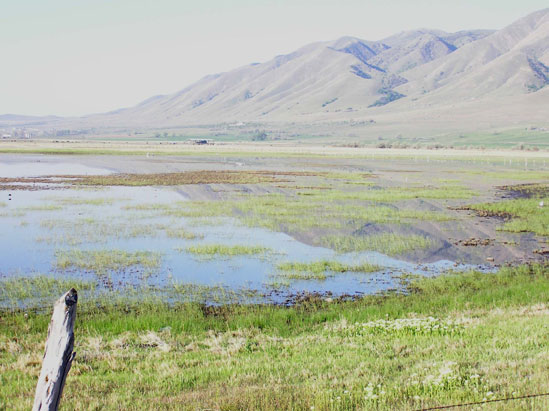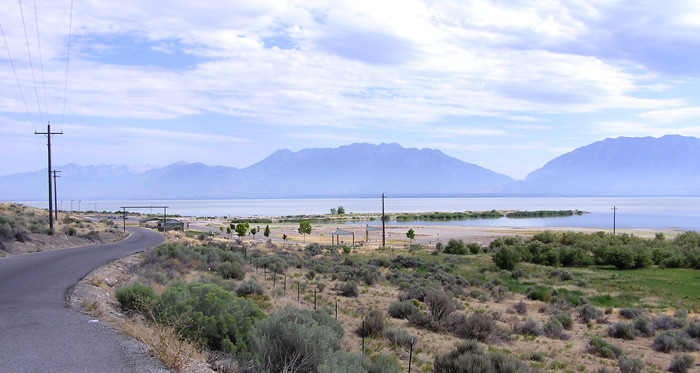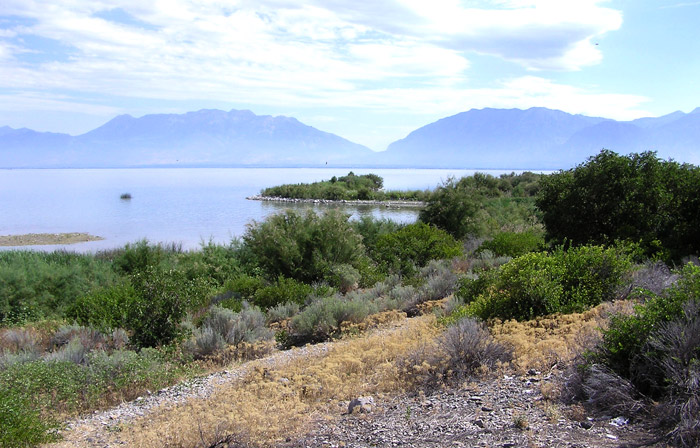|
Lincoln Point & West Mountain - Auto
Tour |
 |
|
Benjamin Slough by Eric Huish ŠEric Huish |
|
eBird Data: |
Swede Lane |
River Lane |
4000 West |
Benjamin Slough |
Lincoln Beach |
LaBarron Point | Start your odometer at the Springville exit on I-15, exit 260 (see Lincoln Point & West Mountain Area Map), and head west on State Road 77 (4000 South). Drive west through the farm land examining trees and power poles for hawks. Great Blue Herons, Turkey Vultures , Snowy and Cattle Egrets, American Kestrels and Red-tailed Hawks and other raptors are often seen along these roads. Examine the raptors carefully as you might find a Golden Eagle. After 4.5 miles, cross the bridge over the Spanish Fork River at N 40 09.036' W 111 43.558', which is a nesting place for swallows. Examine these swallows carefully, as all local swallows are commonly found here. Summer and fall trips will find power lines all along the route covered with flocks of immature and adult swallows. Continue west another .2 miles where the road turns left (south) onto 3200 West. From there drive a mile south and turn right on 5200 S then go 1.5 miles west and turn left then go a half mile south and turn right and go another half mile west then turn left and go a mile south. This will take you to 6300 S and 4800 W at mile 9.1 on your odometer.. While traveling through this farm land, you may see Ring-necked Pheasants, White-faced Ibis, and American Kestrels. At mile 9.3 there is a turn-out where you can see to the south an intermittent pond, N 40 06.976' W 111 46.361' that is often filled with ducks, geese and shore birds. A spotting scope is a must since this pond stretches almost 3/4 of a mile south of the turnout. American Pelicans, Canada Geese, Mallards, Killdeer, Black-necked Stilts, American Avocets, Greater Yellowlegs, Spotted Sandpipers and other birds are commonly seen. |
 |
|
Lincoln Beach by Staff Photographer
ŠUtah Birds (2007) |
| Continue to mile 11.0 where the road turns right (north) and pause in the stand of Silver-leaf Maple found at the corner at N 40 06.851' W 111 48.086'. Bullock"s Orioles and House Sparrows are commonly found in these trees. Proceeding north you will pass a dirt road to your left at mile 12.8 suitable for high clearance automobiles. This road goes to the top of West Mountain where Chukar may be seen about 5% of the time. Most birders will not want to take this road. Continue north to mile 12.9, where on the right (east) side you will find the entrance to Lincoln Beach on Utah Lake, N 40 08.473' W 111 48.170'. Drive down to the beach on this dirt road and stop and look for more shore birds. Snowy Plover may be seen on this beach, but they are small and blend into the surroundings. Western Grebes, an occasional Clark’s Grebe and American Coots are to be seen almost anywhere on Utah Lake. Along the water line are Great Blue Herons, Black-crowned Night Herons and American Pelicans. |
 |
|
Lincoln Point by Staff Photographer
ŠUtah Birds (2007) |
|
Return to the pavement having added .5 mile to your odometer and continue around Lincoln Point, examining both sides of the road. Say’s Phoebes and Sage Thrashers have been seen in the fields on the left at Lincoln Point and Savanna Sparrows are often seen in the bushes between the road and the lake. As you continue around the point, at mile 14, across from the orchards on the left (south) side of the road where Starlings and Brewer’s Blackbirds flock but you might find an occasional Bullock’s Oriole, Red-winged Blackbirds and Yellow-headed Blackbirds. Bird along this road as you head south to mile 22.3 then turn right (west) on a dirt road that goes past an orchard and down the hillside into a grove of trees to LeBarron Point, at N 40 02.972' W 111 52.319'. Stop here to examine the trees carefully. The trees on the north are lower on the hillside and have their branches almost at eye level, and have numerous warblers and finches in them throughout the spring and summer. The trees on the south provide good habitat for flycatchers, hawks and owls. Nesting Red-tail Hawks have been seen on the west end of the grove while a pair of Great Horned Owls often roost on some of the larger branches toward the middle. Examine the trees carefully as the owls blend in very well. If you continue another mile to the left (south) on the dirt road to where it crosses a pond (don’t cross the pond), you can find Soras, Virginia Rails and Marsh Wrens in the marshes on both sides of the road. This is the end of the tour. You can return home the way you came, or you can continue south to Goshen and return to the freeway by way of Santaquin. Going back the way you came may be preferred since you may see birds you missed on the trip out.
|